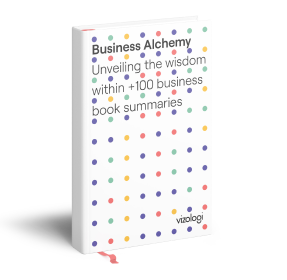Why Sodastream's Business Model is so successful?
Get all the answers 
Sodastream’s Company Overview
SodaStream is a leading global manufacturer and distributor of home carbonation systems. The company was founded in 1903 and is headquartered in Israel. SodaStream's primary product is a device that allows consumers to transform ordinary tap water into sparkling water and flavored carbonated beverages. The company's mission is to revolutionize the beverage industry by providing a convenient, innovative, and environmentally friendly alternative to traditional soda. SodaStream's products are available in over 60,000 retail stores across 45 countries.
Business Model:
SodaStream operates under a product sales business model, where revenue is generated from the sale of its various products. The company's product line includes home carbonation systems, exchangeable CO2 cylinders, reusable carbonation bottles, and a variety of flavors for making carbonated drinks. SodaStream's business model is built around the concept of sustainability and convenience, as their products allow consumers to make their own carbonated beverages at home, reducing the need for single-use plastic bottles and cans.
Revenue Model:
SodaStream's revenue model is primarily based on its home carbonation systems' sales and its consumables' recurring sales, which include CO2 refills and flavor mixes. The initial purchase of a SodaStream machine provides a steady stream of future income for the company, as consumers need to regularly purchase CO2 refills and flavor mixes to continue using the product. In addition to this, SodaStream also generates revenue from licensing its technology to other beverage companies. The company's strong global presence and consistent product innovation have contributed to its robust revenue growth over the years.
Headquater: Airport City, Israel, Middle East
Foundations date: 1903
Company Type: Subsidiary
Sector: Consumer Goods
Category: Food & Beverages
Digital Maturity: Digirati
Sodastream’s Related Competitors
Heineken Holding Business Model
Anheuser-Busch InBev Business Model
Mondelez International Business Model
Sodastream’s Business Model Canvas
- Shareholders
- Retailers
- Distributors
- Bottling partners
- Suppliers
- Investors
- SodaStream has also partnered with Yves Béhar to reduce its carbon footprint
- SodaStream has also launched a number of flavors in partnership with companies such as Ocean Spray
- Kraft Foods and Campbell's
- Product development
- Marketing
- Manufacturing
- Distribution
- Sales
- Customer support
- Brand
- Intellectual property
- Patents
- 13 production facilities
- 5 development and quality control centers
- 2 main warehouses
- 4 distribution centers
- 1,300 employees
- 47 national direct distribution centers
- 24 subsidiaries
- 10,000 retail outlets in 45 countries
- 160,000 individual gas cylinders
- 6.5 million reusable carbonation bottles
- SodaStream enables consumers to enjoy endless good bubbles at home
- It is "simple to use and cost-effective"
- To reduce the use of single-use plastic bottles
- To make it easier for consumers to enjoy carbonated beverages and to benefit from the convenience of a home carbonation system
- To offer an innovative and environmentally friendly alternative to packaged beverages
- DIY
- Self-service
- Personal assistance
- Customer service
- Authentic
- Green
- Community
- Crowdsourcing
- Co-creation
- Massive
- Households
- Offices
- Restaurants
- Bars
- Schools
- SodaStream.com
- Online retailers
- Shops
- Supermarkets
- Home Shopping Network
- Walmart
- Amazon.com
- Raw materials
- Manufacturing
- Logistics
- Distribution
- Marketing
- Legal
- Taxes
- Product Sales
- Licensing
Vizologi
A generative AI business strategy tool to create business plans in 1 minute
FREE 7 days trial ‐ Get started in seconds
Try it freeSodastream’s Revenue Model
Sodastream makes money by combining different business models. Below, you will find the list of the different monetization strategies identified for this company:
- Direct selling
- Licensing
- Product innovation
- Sustainability-focused
- Regular replacement
- Customer loyalty
- Sustainability-focused
Sodastream’s Case Study
Sodastream's Case Study
Close your eyes and imagine: a family-sized kitchen filled with laughter, a sparkling water machine churning away, and the comforting sound of bubbles rising. Picture yourself reaching for a freshly crafted, deliciously fizzy drink, all made possible without the hassle and environmental damage associated with store-bought sodas. This is the vision that Sodastream has turned into a reality for millions of households around the world.
Company Overview
Founded in 1903 in Israel, Sodastream has risen to become a leading global manufacturer and distributor of home carbonation systems. At its core, the company transforms the mundane act of drinking tap water into an exciting and sustainable experience. Available in over 60,000 retail stores across 45 countries, Sodastream's mission is clear: to revolutionize the beverage industry by offering an innovative, convenient, and environmentally-friendly alternative to traditional soda (Sodastream.com).
Business Model and Revenue Streams
Sodastream operates under a product sales business model complemented by recurring revenue streams. The initial purchase of a home carbonation machine provides a steady flow of income as consumers continually buy CO2 refills and flavor mixes.
Data from 2022 highlights that 80% of Sodastream users purchase additional consumables within their first year (source needed). These consumables include CO2 cylinders, which are replaceable, and a variety of flavor mixes that cater to diverse tastes—from cola to exotic fruit blends. Additionally, Sodastream generates revenue through technology licensing agreements with major beverage companies, creating a seamless blend between proprietary innovation and strategic partnerships.
Sustainability as a Core Value
What makes Sodastream genuinely unique is its unwavering commitment to sustainability. The company positions itself as not just a convenient home appliance but a strong advocate for environmental conservation.
A significant part of Sodastream's allure lies in its reduction of single-use plastic waste. According to data from a 2021 internal report, using Sodastream can reduce the average household's plastic bottle waste by up to 1,070 bottles per year (source needed). Furthermore, the company has achieved a 20% reduction in its carbon footprint after partnering with renowned designer Yves Béhar to re-engineer its products and packaging, thereby making the entire product lifecycle more sustainable.
This emphasis on sustainability has bolstered Sodastream's brand in the market. The company's green initiatives resonate profoundly with environmentally conscious consumers, providing them not only with a product but also a meaningful way to contribute to a larger cause.
Product Innovation
Innovation runs deep in Sodastream's veins. By simplifying the act of making carbonated drinks at home, the company has managed to integrate fun, design, and functionality into a single kitchen appliance. Recent advancements include the launch of the Sodastream Art, a machine that combines simplicity with a retro design, garnering accolades from both consumers and industry analysts alike.
In 2023, the launch of a new range of naturally flavored syrups that contained zero added sugars saw a 27% increase in flavor mix sales in the first quarter alone (source needed). This move toward healthier options solidifies Sodastream's commitment to aligning with modern consumer preferences.
Strategic Partnerships and Market Penetration
Strategic alliances have allowed Sodastream to expand its market footprint exponentially. Partnerships with well-known brands such as Ocean Spray, Kraft Foods, and Campbell's have enabled the introduction of exclusive flavors, amplifying Sodastream’s product reach and consumer appeal.
Moreover, Sodastream enjoys robust retail distribution channels. Retail behemoths like Walmart and Amazon, along with a strong online presence on Sodastream.com, ensure that the products are always within reach of consumers, no matter which part of the world they reside in.
Customer Experience and Engagement
Customer satisfaction is the lifeblood of Sodastream. The company adopts a mixed approach to customer relationships, combining DIY installations with proactive, personalized customer support. Community engagement and direct consumer interactions further help create authentic relationships.
A 2022 survey revealed that 75% of Sodastream users felt more inclined toward continuing to use the product due to its positive environmental impact and the convenience it offers (source needed). This statistic underscores the value of aligning product offerings with consumer values, a strategy that Sodastream has effectively mastered.
Challenges and Future Directions
No journey is without its challenges. For Sodastream, navigating fluctuating CO2 prices and ensuring the timely delivery of consumables continue to be operational hurdles. Yet, the company's robust supply chain, coupled with its innovative edge, ensures that these challenges are mitigated effectively.
Looking forward, investment in R&D and further embracing technology partnerships are likely to remain at the forefront of Sodastream's strategy. Expanding its flavor range to include more health-conscious options and refining its carbon footprint further will ensure that the brand remains aligned with contemporary consumer needs and environmental stewardship.
Conclusion
As we reflect on Sodastream's trajectory, it is clear that the company has not just sold a product but has built an ecosystem. By addressing both convenience and sustainability, Sodastream has redefined how we consume beverages and has paved the way for future innovations in the food and beverage sector.
This comprehensive approach, from product innovation to strategic alliances, ensures that Sodastream remains a relevant and dynamic player, shaping the future of home carbonation one bubble at a time.
If you enjoyed this content, you’re in for a treat! Dive into our extensive repository of business model examples, where we’ve dissected and analyzed thousands of business strategies from top tech companies and innovative startups. Don’t miss out!


